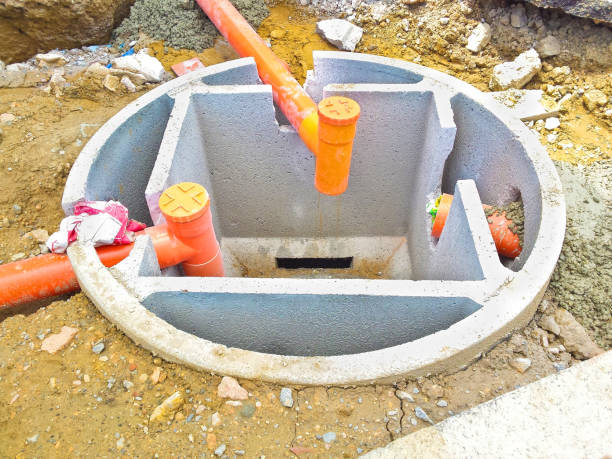As urban areas continue to grow, managing stormwater runoff has become a critical challenge.
Traditional stormwater management systems, such as gutters, drains, and large detention basins, often struggle to cope with the increasing volume of runoff from impervious surfaces like roads, rooftops, and pavements.
In response to this, innovative soakwell technologies are transforming stormwater management practices by offering more efficient, sustainable, and environmentally friendly solutions.

In this article, we will examine how soakwells have evolved with the advent of new technologies and how they are contributing to better stormwater management.
Understanding how do soakwells work in this context will help highlight their role in tackling the growing pressures on urban water systems.
What Is a Soakwell and Its Role in Stormwater Management?
Definition of a Soakwell
A soakwell is an underground structure designed to capture and store excess rainwater from downspouts, drains, and other stormwater runoff sources.
Once collected, the water is allowed to infiltrate the surrounding soil, helping to prevent flooding, reduce runoff, and replenish groundwater. The water gradually percolates through the soil, providing an efficient and sustainable solution for stormwater management.
Traditional vs. Modern Soakwell Systems
While traditional soakwell systems primarily focused on simple water storage, recent innovations have introduced advanced features aimed at improving efficiency, capacity, and environmental sustainability.
These new technologies are designed to accommodate increased rainfall due to climate change, urban expansion, and higher impervious surfaces.
Innovative Soakwell Technologies
1. Modular Soakwells
Modular soakwells are a cutting-edge solution that offers flexibility and adaptability to various property sizes and water runoff requirements. These soakwells consist of individual modules that can be stacked together to create a larger unit, allowing for easy customization.
Benefits of Modular Soakwells:
Customisable Size
The modular design allows for easy expansion or contraction, depending on stormwater management needs.
Space-Efficient
Modular units can be installed in a range of locations, including under driveways, gardens, and patios, without taking up excessive space.
Durable
Made from high-quality materials like polypropylene or concrete, modular soakwells are designed to withstand heavy loads and extreme weather conditions.
2. Plastic Soakwells
Plastic soakwells have become increasingly popular due to their lightweight design, durability, and cost-effectiveness. They are particularly well-suited for residential and smaller commercial properties.
These systems are often made from high-density polyethylene (HDPE), which provides strength, flexibility, and resistance to cracking or corrosion.
Advantages of Plastic Soakwells:
Lightweight
Easier to transport and install, making them ideal for DIY installations.
Durable and Long-Lasting
Plastic materials are resistant to rust, corrosion, and UV degradation.
Cost-Effective
Generally more affordable than concrete alternatives, making them an attractive option for smaller budgets.
3. Smart Soakwells with Monitoring Systems
Advancements in smart technology have led to the development of soakwells with integrated monitoring systems. These systems use sensors to track the water levels, flow rates, and the overall performance of the soakwell.
Data collected from these sensors can be transmitted to a smartphone app or central control system for real-time monitoring.
Key Features of Smart Soakwells:
Remote Monitoring
Property owners and managers can remotely monitor water levels and system performance via an app or dashboard.
Predictive Maintenance
The system can alert users to potential issues, such as blockages or system failure, allowing for proactive maintenance.
Optimised Water Management
Smart soakwells can adjust their operation based on rainfall patterns, ensuring that stormwater is managed efficiently without overloading the system.
4. Soakwell with Filtration Systems
In some regions, stormwater runoff carries pollutants such as oils, debris, chemicals, and nutrients that can degrade water quality.
To address this issue, modern soakwell technologies now incorporate filtration systems that help remove contaminants before the water is released into the ground.
Features of Filtration-Enhanced Soakwells:
Sediment and Pollutant Removal
Filtration systems trap particles and pollutants before they can infiltrate the soil.
Improved Water Quality
By removing contaminants, these systems ensure that only clean water enters the groundwater table, reducing the risk of groundwater pollution.
Sustainable Design
These systems support the principles of sustainable urban drainage by preventing polluted runoff from entering local waterways.
5. Rechargeable Soakwells
Rechargeable soakwells are designed to capture excess rainwater and store it for later use, such as irrigation or landscape watering.
These soakwells incorporate a secondary storage tank that allows water to be reused, making them an environmentally friendly option for properties looking to conserve water.
Rechargeable Soakwell Benefits:
Water Conservation
By storing and reusing water, these systems reduce the demand for potable water and lower water bills.
Dual Purpose
In addition to stormwater management, these systems provide an additional water supply for non-potable uses such as irrigation, cleaning, and landscape maintenance.
Sustainability
These soakwells contribute to reducing overall water consumption and promote more sustainable water practices.
The Environmental Impact of Innovative Soakwell Technologies
1. Reducing Urban Runoff
Urban areas with large paved surfaces are particularly susceptible to stormwater runoff, which can overwhelm drainage systems and lead to flooding.
Innovative soakwell technologies help mitigate this issue by efficiently managing runoff on-site, reducing the need for extensive stormwater infrastructure and protecting local waterways from pollution.
Environmental Benefits:
Flood Prevention
Soakwells reduce the risk of flooding by capturing excess water and allowing it to infiltrate the ground.
Water Pollution Control
By filtering pollutants and controlling runoff, soakwells help maintain cleaner water bodies and support healthier ecosystems.
2. Supporting Groundwater Recharge
One of the most significant environmental benefits of soakwells is their ability to recharge groundwater supplies. In regions where groundwater levels are low, soakwells help restore aquifers by allowing water to infiltrate the soil and replenish underground water reserves.
Groundwater Recharge Benefits:
Sustainable Water Supply
Groundwater recharge helps ensure a reliable source of fresh water for drinking, irrigation, and other uses.
Ecosystem Support
Groundwater plays a crucial role in supporting vegetation, agriculture, and wildlife. Soakwells help maintain this balance.
3. Mitigating the Urban Heat Island Effect
Urban heat islands occur when cities experience higher temperatures than surrounding rural areas due to the absorption of heat by impervious surfaces.
Soakwells contribute to mitigating this effect by promoting the infiltration of water into the ground, reducing the amount of heat absorbed by concrete and asphalt.
How Soakwells Help:
Cooling Effect
Water infiltration supports evapotranspiration, a natural process where plants release moisture into the air, cooling the surrounding environment.
Lower Surface Temperatures
By reducing water runoff and promoting natural absorption, soakwells help reduce the heat retained by urban surfaces.
The Future of Soakwell Technology
1. Integration with Smart Cities
As cities move towards becoming “smart” through the integration of IoT (Internet of Things) technology, soakwells are likely to become part of this transformation.
Smart sensors and data-driven decision-making will help optimise stormwater management systems, making them more responsive and efficient in real-time.
Future Trends:
Real-time Data
Smart soakwells can collect data about water levels, rainfall patterns, and system performance, providing actionable insights for better stormwater management.
Automated Adjustments
Soakwell systems may be able to automatically adjust their capacity to handle varying water volumes, preventing overflow and reducing strain on urban drainage systems.
2. Eco-Friendly Materials and Designs
As environmental concerns continue to rise, the materials used in soakwell technologies are becoming more eco-friendly.
Companies are developing biodegradable or recyclable materials for soakwell construction, making these systems more sustainable and reducing their environmental footprint.
Eco-Friendly Innovations:
Recycled Materials
Soakwell systems made from recycled plastic or other sustainable materials help reduce waste and environmental impact.
Natural Filtration Systems
Future designs may incorporate more advanced natural filtration methods, using plants and soil to further improve water quality.
Conclusion
Innovative soakwell technologies are transforming stormwater management by offering efficient, sustainable solutions for reducing runoff, replenishing groundwater, and improving water quality.
From modular designs and smart technologies to filtration systems and eco-friendly materials, modern soakwells are contributing to a more sustainable approach to urban water management.
As cities continue to grow and face the challenges of climate change, these innovative solutions will play a key role in ensuring that stormwater is managed effectively and efficiently.
Frequently Asked Questions
What is the difference between a traditional soakwell and a modular soakwell?
Traditional soakwells are typically made from a single unit, while modular soakwells consist of interlocking units that can be combined to create a larger system. Modular soakwells are more flexible and can be customised to meet specific water management needs.
How do smart soakwells work?
Smart soakwells are equipped with sensors that monitor water levels, flow rates, and overall system performance. This data is transmitted in real time, allowing property owners or managers to monitor and maintain the system remotely, ensuring it functions optimally.
Can soakwells be used in all types of soil?
Soakwells are most effective in soils with high permeability, such as sandy or loamy soils. In areas with low-permeability soils, such as clay, additional measures like a larger soakwell or drainage enhancements may be necessary.
